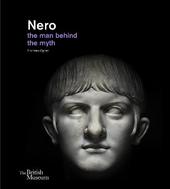
|
Nero: the man behind the myth
Hardback
Main Details
| Title |
Nero: the man behind the myth
|
| Authors and Contributors |
By (author) Thorsten Opper
|
| Physical Properties |
| Format:Hardback | | Pages:304 | | Dimensions(mm): Height 280,Width 250 |
|
| Category/Genre | World history |
|---|
| ISBN/Barcode |
9780714122908
|
| Classifications | Dewey:937.07092 |
|---|
| Audience | |
|---|
| Illustrations |
280 Illustrations, unspecified
|
|
Publishing Details |
| Publisher |
British Museum Press
|
| Imprint |
British Museum Press
|
| Publication Date |
12 August 2021 |
| Publication Country |
United Kingdom
|
Description
One of the best known figures from Roman history, Nero (r. AD 54-68) is most often characterised as a tyrannical and ineffectual ruler, who fiddled while Rome burnt. Such a reputation has, however, been shaped by ancient literary sources written by his adversaries and enemies and, in light of new research, can be considered crudely reductive. This publication, and the exhibition it accompanies, redresses the balance and provides a more nuanced interpretation of Nero's reign and Roman society of the time, reflecting on the traditional perceptions of his rule and revealing the challenges with which the young heir to Claudius' empire had to contend. The period during which Nero ruled over Roman society was one of profound change. The extent of the empire at the time was vast, having grown significantly during the previous century through conquest and annexation, and peace and prosperity followed years of bloody war. The role of Nero's mother Agrippina in his accession to the throne is well-documented, but her expectations of great influence once Nero was in post were not met and the role of women, and family more widely, is considered in detail in this book. In addition to familial conflict, Nero also had to confront the threat of rival powers and the assimilation of newly conquered territories, which provided him with the opportunity to prove himself as a strong military leader. Alongside military campaigns, he adopted 'populist' policies, was preoccupied with the beautification of the heart of his empire, which was subsequently devastated by fire, and enthusiastically engaged in theatre and entertainment. Nero's rule was curtailed by military rebellion in AD 68 and the embattled emperor ultimately committed suicide. His death brought to an end the reign of the Julio-Claudian dynasty, and the subsequent vilification of his memory and the removal and desecration of his image are an enduring, but misleading, legacy.
Author Biography
Thorsten Opper is Curator of Greek and Roman sculpture at the British Museum. He is the author of Hadrian: empire and conflict and curator of the exhibition Nero at the British Museum.
Reviews"Roman historians of the first and second centuries CE, chiefly aristocrats, considered Nero (r. 54-68 CE) the last of the Julio-Claudians (27 BCE-68 CE) and a monster responsible for the great fire that destroyed much of Rome and for undermining the economy with lavish expenditures on his palace, the Golden House. Modern scholars have tended to accept this assessment, depicting Nero as a megalomaniac and an incompetent who brought the empire to the brink. Relying largely on contemporary artifacts such as frescoes, statues, military equipment, papyri, medallions, and coins, Opper (British Museum) instead argues that Nero ruled effectively and relatively humanely. Nero partially succeeded in integrating the provinces into the empire and incorporating a large, talented freedmen element into society. Further, his economic policies stimulated the economy, and his cultural interest was similar to the great emperors of the next century. Nero's effectiveness is reflected in his popularity after his death. Despite executing many senators, he failed to liquidate the seditious elements within the aristocracy, which had compromised four preceding emperors. In view of Nero's murdering his mother, this persuasive rehabilitation is only partially successful. This erudite, well-written work has 225 excellent illustrations. Summing Up: Recommended. Lower-division undergraduates through faculty."--A. J. Papalas "CHOICE, November 2022 Vol. 60 No. 3"
|